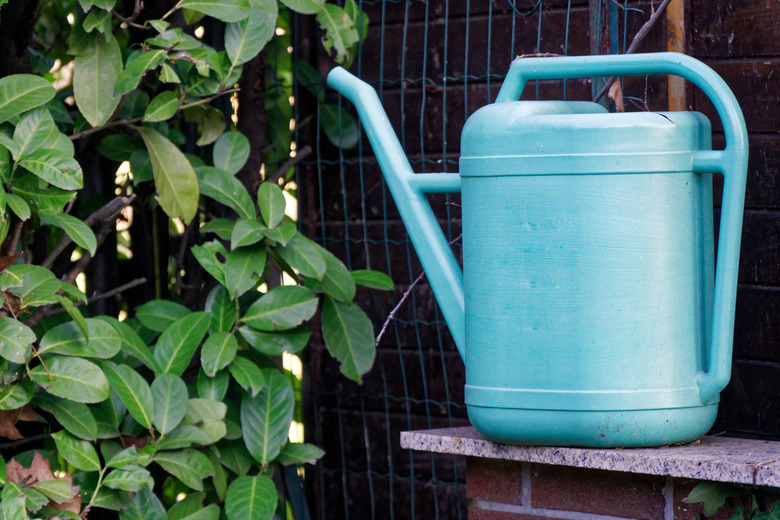The Best Methods To Remove Oxidation From Plastic
Plastics remain a valuable material for many products used in everyday life and in more specialized settings. They include durable and non-durable goods, bags, packaging and containers, beverage and food containers. They make up cars, boats and the siding of homes. Despite their lightweight, affordable qualities, however, they do succumb to degradation. Degradation causes include chemical, thermal, biological sources and sunlight. One form of degradation, oxidization, leads to an unpleasant appearance on plastic surfaces. You can remove oxidation in a number of ways.
TL;DR (Too Long; Didn't Read)
Plastics, while durable and affordable, may degrade over time due to exposure to the elements, especially oxygen. Oxidation of plastic leaves an undesirable appearance and the potential for more rapid degradation. Fortunately, many everyday plastic items can be restored at home via various polishing techniques and solutions.
Causes of Plastic Oxidation
Causes of Plastic Oxidation
Chemicals in plastic react with oxygen in the air. The oxidation of plastics leads to degradation. Plastics become physically abraded or are subject to sunlight, air pollution, moisture, high temperature and biological exposure. Ultraviolet B radiation (UVB) breaks down plastics via photo-oxidation. Eventually this leads to brittle, cracking plastic. While more modern plastics contain stabilizing additives, older plastics may not, and suffer more risk of degradation. In the case of ebonite, which contains sulfur compounds, reaction with oxygen occurs and eventually water as well, ultimately leading to sulfuric acid production. Storing some plastics, particularly museum pieces, in an oxygen-free area may be warranted. There are oxygen-absorbing products that seal plastics. Additionally, reducing exposure of plastic to sunlight can stave off photo-oxidation. In most cases, however, these steps are impractical, especially for outdoor items. In that situation, some methods exist to help restore plastic surfaces.
Plastic Restoration Methods
Plastic Restoration Methods
Many oxidized plastics can be restored at home. The surface needing restoration should be washed gently and rinsed thoroughly before proceeding. For highly valuable and museum pieces, expert restoration is advised.
Vinyl siding covers the exterior of many homes in the modern world. Because of its exposure to air, oxidation can occur. It presents as a chalky substance on the siding. Wet weather makes it more susceptible to this oxidation. However, the oxidation can be removed. The process involves rinsing the siding in a downward direction with water to remove excess dirt. A mixture of five cups of vinegar and one gallon of hot water can be applied via a spray bottle onto the affected area. Long-handled, soft-bristled cleaning brushes help to remove the oxidation. Continuing this manner in small sections works best so the solution does not dry out. Then the material can be hosed downward. For more pernicious oxidation, a mixture of 1/3 cup of laundry detergent, 2/3 cup of household cleaner, one quart of household bleach and one gallon of water may be used instead of the vinegar mixture. Work safely with goggles and an assistant with any ladders.
Car headlights, while made of long-lasting and scratch-resistant polycarbonate, can also degrade over time. This affects the clarity and appearance of the headlights' exterior. Fortunately, polishing the surface can restore polycarbonate. The car must be washed to clean off excess dirt. The area around the headlights should be masked off with tape to prevent any damage to other surfaces. An abrasive material such as sandpaper should be used to remove the hazy outer layer of oxidation. Then a water-soaked 1000-grit sandpaper can be used to sand the lens lightly and methodically. All pits and scratches should be eliminated, checked, and re-sanded as needed to achieve smoothness. The headlight should then be dried. Next, sand again with wet, 1500-grit sandpaper at right angles to the previous sanding. This should be repeated with wet 2000-, 2500- and 3000-grit sandpaper at alternating angles. After sanding and cleaning any residue, apply a polishing compound with a cloth in a circular motion. If there are still defects after polishing, clean the surface and wax with a paste car wax to protect the polycarbonate from the elements.
For boat surfaces, cleaning agents approved for fiberglass gelcoats should be used to wash the surface. To restore surface irregularities, a sealing compound or mild polish specifically made for boats can be applied. Liquid polish can be applied by hand with cloth. Polishing paste entails the use of a buffer with a buffing pad. Much heavier oxidation may require application of a cutting compound. Once the oxidized area is polished, the surface must be sealed with two coats of polymer polish. This seals and protects the surface from further wear until the next season.
Cautionary Note
Cautionary Note
Oxidation of plastic affects its look and appeal. However, plastic degradation also leads to the release of volatile organic compounds (VOCs) from the plastic. This off-gassing of compounds can lead to eye irritation and other symptoms. Additionally, dust from polished-off residue can irritate. When handling plastics, wear protective eyewear and gloves, and wash hands to prevent skin exposure.
References
- Popular Mechanics: How to Make Your Headlights Shine Like New
- Smithsonian Institution Eco Exchange Newsletter of the SI Green Team Volume 4 Issue 1 Winter 2009: Safe Handling of Plastics
- Government of Canada: Care of Objects Made from Rubber and Plastic – Canadian Conservation Institute (CCI) Notes 15/1
- West Marine: Do-it-Yourself: Maintaining Your Boat's Gelcoat Finish
- NOAA Office of Response and Restoration: How Beach Cleanups Help Keep Microplastics out of the Garbage Patches
Cite This Article
MLA
Hermance, Dianne. "The Best Methods To Remove Oxidation From Plastic" sciencing.com, https://www.sciencing.com/methods-remove-oxidation-plastic-8716902/. 17 May 2018.
APA
Hermance, Dianne. (2018, May 17). The Best Methods To Remove Oxidation From Plastic. sciencing.com. Retrieved from https://www.sciencing.com/methods-remove-oxidation-plastic-8716902/
Chicago
Hermance, Dianne. The Best Methods To Remove Oxidation From Plastic last modified March 24, 2022. https://www.sciencing.com/methods-remove-oxidation-plastic-8716902/
